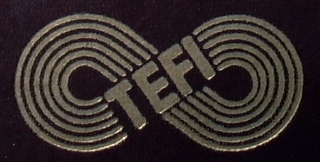
Magnetic tape is a medium for magnetic storage made of a thin, magnetizable coating on a long, narrow strip of plastic film. It was developed in Germany in 1928, based on the earlier magnetic wire recording from Denmark. Devices that use magnetic tape could with relative ease record and playback audio, visual, and binary computer data.

The Compact Cassette, also commonly called a cassette tape, audio cassette, or simply tape or cassette, is an analog magnetic tape recording format for audio recording and playback. Invented by Lou Ottens and his team at the Dutch company Philips, the Compact Cassette was released in August 1963. Compact Cassettes come in two forms, either containing content as a prerecorded cassette (Musicassette), or as a fully recordable "blank" cassette. Both forms have two sides and are reversible by the user. Although other tape cassette formats have also existed—for example the Microcassette—the generic term cassette tape is normally used to refer to the Compact Cassette because of its ubiquity.

The 8-track tape is a magnetic-tape sound recording technology that was popular from the mid-1960s to the early 1980s, when the compact cassette, which pre-dated the 8-track system, surpassed it in popularity for pre-recorded music.

Video 2000 is a consumer videocassette system and analogue recording standard developed by Philips and Grundig to compete with JVC's VHS and Sony's Betamax video technologies. It was designed for the PAL color television standard, but some models additionally handled SECAM. Distribution of Video 2000 products began in 1979 exclusively in Europe, South Africa and Argentina and ended in 1988.

VHS-C is the compact variant of the VHS videocassette format, introduced by Victor Company of Japan (JVC) in 1982, and used primarily for consumer-grade compact analog recording camcorders. The format is based on the same video tape as is used in VHS, and can be played back in a standard VHS VCR with an adapter. An improved version named S-VHS-C was also developed. S-VHS's main competitor was Video8; however both became obsolete in the marketplace by the digital video formats MiniDV and MiniDVD, which have smaller form factors.

PlayTape is a 1⁄8 inch (3.2 mm) audiotape format and mono or stereo playback system introduced in 1966 by Frank Stanton. It is a two-track system, and was launched to compete with existing 4-track cartridge technology. The cartridges play anywhere from eight to 24 minutes, and are continuous. Because of its portability, PlayTape was an almost instant success, and over 3,000 artists had published in this format by 1968. White cases usually meant about eight songs were on the tape.

Pocket Rockers was a brand of personal stereo produced by Fisher-Price in the late 1980s, aimed at elementary school-age children. They played a proprietary variety of miniature cassette which was released only by Fisher-Price themselves. Designed to be as much of a fashion accessory as a music player, the devices were enough of a youth craze to even be banned in some schools for a brief period.

The RCA tape cartridge is a magnetic tape audio format that was designed to offer stereo quarter-inch reel-to-reel tape recording quality in a convenient format for the consumer market. It was introduced in 1958, following four years of development. This timing coincided with the launch of the stereophonic phonograph record. It was introduced to the market by RCA in 1958.

YouTube is an American online video-sharing platform headquartered in San Bruno, California, founded by three former PayPal employees—Chad Hurley, Steve Chen, and Jawed Karim—in February 2005. Google bought the site in November 2006 for US$1.65 billion, since which it operates as one of Google's subsidiaries.
The Seeburg 1000 Background Music System is a phonograph designed and built by the Seeburg Corporation to play background music from special 162⁄3 RPM vinyl records in offices, restaurants, retail businesses, factories and similar locations. Seeburg provided a service similar to that of Muzak.

The Tefifon is an audio playback format, developed and manufactured in Germany, that utilizes cartridges loaded with an endlessly looped reel of plastic tape. It is somewhat similar to the later 4-track and 8-track magnetic audio tape cartridges, but with grooves embossed on the tape, like a phonograph record. The grooves were embossed in a helical fashion across the width of the tape, in a manner similar to Dictaphone's Dictabelt format. The grooves are read with a stylus and amplified pickup in the player's transport. A Tefifon cartridge, known as a "Tefi", can hold up to four hours of music; therefore, most releases for the format are usually compilations of popular hits or dance music, operas, and operettas. Tefifon players were not sold by television and radio dealers in Germany, but rather sold directly by special sales outlets affiliated with Tefi.

The Cantata 700 is a commercial background music system and corresponding cartridge format developed by 3M that was in common use from 1965 until the 1990s.

Sabamobil was a magnetic tape audio cartridge format made by SABA that came to the market in 1964. It used already-available four-track ¼ inch tape on 3-inch reels (7.62 cm), with two mono channels per side, using a tape speed of 3¾ ips (9.5 cm/s), and was compatible with reel-to-reel audio tape recording except the against remove secured ends of the tape in the reel. The cartridge could be opened without the need of any tools by removing two holding clamps. Tape head and capstan were placed between the reels.

The OMNI Entertainment System was an electronic stand-alone game system produced by the MB Electronics division of the Milton Bradley Company, released in 1980.

The Sanyo Micro Pack 35 was a portable magnetic audio tape recording device, developed by Sanyo in 1964, that employed a special tape cartridge format with tape reels atop each other.
HiPac, is an audio tape cartridge format, introduced in August 1971 on the Japanese consumer market by Pioneer and discontinued in 1973 due to lack of demand. In 1972 it only achieved a market share of 3% in equipping new cars. In the mid 1970s, the format was repurposed as a children's educational toy called ポンキー and was used in the analog tape delay "Melos Echo Chamber".
The single-hole cassette,, was a concept of a high fidelity suitable magnetic tape cartridge or cassette from Philips for analog recordings. Tape and tape speed were identical to the Compact Cassette. It was never released to the public.

DC-International is a tape cassette format developed by Grundig and marketed in 1965. DC is the abbreviation of "Double Cassette", as the cassette contained two reels; International was intended to indicate that, from the beginning, several companies around the world supported the format with suitable tape cassette tape recorders, recorded music cassettes and blank cassettes. Since DC-International did not compete effectively against the similar Compact Cassette, it was discontinued in 1967.

Clint Basinger, better known as LGR, is an American YouTuber who focuses on video game reviews, retrocomputing, and unboxing videos. His YouTube channel of the same name has been compared to Techmoan and The 8-Bit Guy. Basinger is known for building, restoring and reviewing many vintage computers and reviewing mainly PC games. The channel is funded through YouTube advertising, and through Patreon.

Peter Leigh, more commonly known by the alias Nostalgia Nerd, is a British presenter, YouTuber, author and Twitch streamer, who documents and specialises in ageing technology and software. First appearing on YouTube in 2014, he routinely and enthusiastically explores forgotten computers and the technology surrounding them. He often specialises in historical documentaries on vintage computing, but also delves into technical explanations. Leigh also ventures into modern, mystery, explanation and more frivolous tech videos, with a humorous style and British wit.














